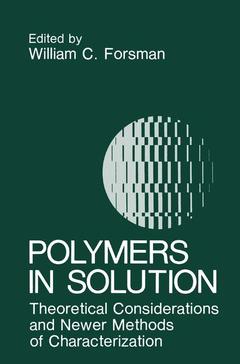Description
Polymers in Solution, Softcover reprint of the original 1st ed. 1986
Theoretical Considerations and Newer Methods of Characterization
Coordinator: Forsman W.C.
Language: English
Subjects for Polymers in Solution:
Keywords
macromolecule; neutron scattering; polymer; polymer science; polymers
Publication date: 06-2013
304 p. · 15.5x23.5 cm · Paperback
304 p. · 15.5x23.5 cm · Paperback
Description
/li>Contents
/li>
Polymers in Solution was written for scientists and engineers who have serious research interests in newer methods for characterization of polymer solutions, but who are not seasoned experts in the theoretical and experimental aspects of polymer science. In particular, it is assumed that the reader is not familiar with the development of theoretical notions in conformational statistics and the dynamics of chainlike molecules; how these two seemingly diverse theoretical topics are related; and the role played by polymer-solvent interactions. Chapter 1 thus presents background material that introduces most of the essential concepts, including some of the mathematical apparatus most commonly used in these areas of theory. This introduction is followed by five chapters that are more closely related to particular experimental techniques. These chapters introduce further theoretical notions as needed. Three of the chapters present con siderable detail on the experimental methods, while two other chapters deal more with the interpretation of experimental results in terms of current theories. Although neutron scattering has become an almost standard technique for the study of conformational properties of macromolecules in the solid state, there has been less emphasis on its application for characterization of polymer molecules in solution. Chapter 4 covers this growing area of application.
1. Statistics and Dynamics of Polymer Molecules in Solution.- 2. Dielectric and Electroviscous Properties in Flowing Polymer Systems.- 3. Entanglement Effects in Polymer Solutions.- 4. Neutron Scattering from Macromolecules in Solution.- 5. Molecular Motion in Concentrated Polymer Systems: High Frequency Behavior.- 6. Pulse-Induced Critical Scattering (PICS), Its Methods and Its Role in Characterization.
© 2024 LAVOISIER S.A.S.




